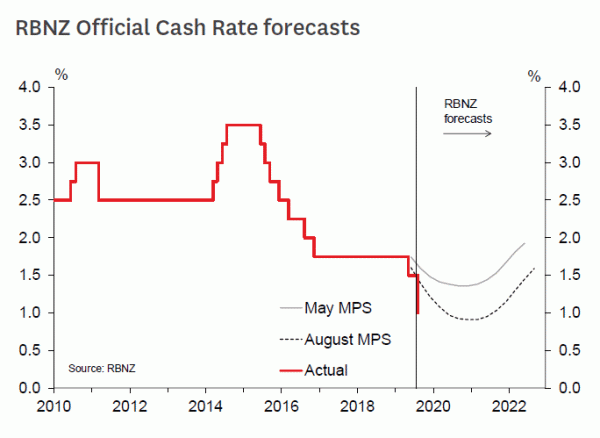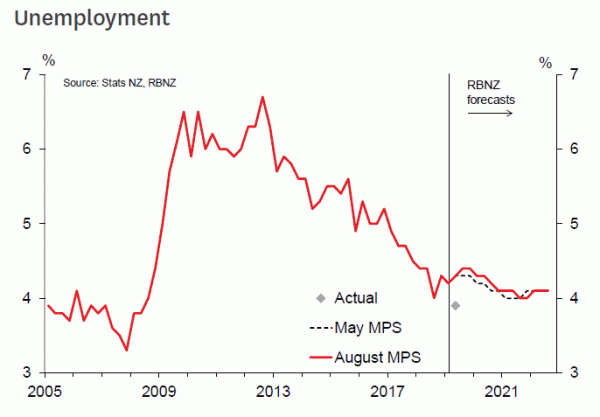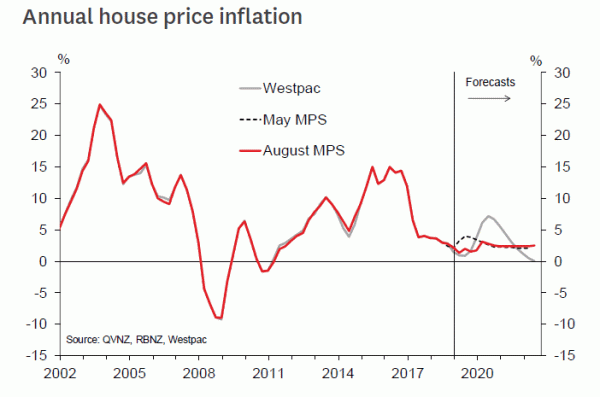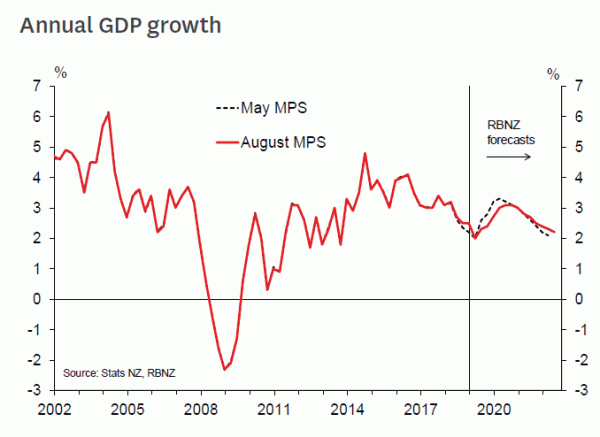- The RBNZ has made an unprecedented decision to cut the OCR 50 bps in a nonemergency situation.
- There was no signal of imminent further cuts, so we doubt the RBNZ will move again in September.
- But the new MPC has shown its willingness to react to adverse economic news, and the current downturn is likely to get worse before it gets better.
- Therefore, we now expect the RBNZ to cut the OCR to 0.75% in November.
- The consequence of this will be a housing market upturn.
- We were already forecasting 7% house price inflation next year, and the risk to that call is now to the upside.
RBNZ Official Cash Rate forecasts
We went into today’s RBNZ decision expecting a big change in stance from the central bank, given recent weak economic data in New Zealand and the escalation in the US/ China trade war. But we expected that would take the form of a 25 basis point cut and a signal of more to come.
The RBNZ’s decision to instead cut the OCR by 50 basis points to 1.00% was stunning. In the history of the OCR, the only meetings at which the OCR has been cut by more than 25 basis points have been immediately after the 9/11 terrorist attack, during the most alarming days of the Global Financial Crisis, and immediately after the Christchurch earthquake. The Reserve Bank has never before decided on a 50 basis point OCR cut in an environment like today, which is deteriorating but is not an emergency.
The RBNZ appears to be trying to get ahead of the curve. Based on the RBNZ’s OCR forecast, it appears that Bank staff presented the Monetary Policy Committee (MPC) with a forecast that the OCR would need to drop to around 0.9% by the second half of next year. The MPC considered the option of cutting 25 basis points and signalling the likelihood of a further move, but instead decided to drop the OCR to 1% all at once. There was no signal in the press release or elsewhere in the document indicating that the RBNZ thinks the OCR will need to be reduced further, although the 0.9% OCR forecast does leave the door open. This was similar to the May MPS, in which the RBNZ justified its current move rather than signalling any future move.
Given the lack of an easing bias, combined with the RBNZ’s demonstrated tendency to move on Monetary Policy Statement dates rather than at OCR Reviews, we doubt that the RBNZ will cut the OCR again in September.
However, we do now expect that the RBNZ will cut the OCR to 0.75% at the time of the November MPS.
Today we have learned that the RBNZ’s new Monetary Policy Committee (MPC) is very aggressive and willing to cut the OCR in response to adverse economic news. Given that we do expect further adverse economic news between now and November, it follows that another cut is likely. The recent escalation of the trade war is likely to cause New Zealand export commodity prices to fall in the near future, including a possible worsening in the export log price downturn. Domestic economic data is more likely to get worse before getting better, meaning there is a good chance that the RBNZ will have to rethink its near-term GDP forecasts of 0.6% and 0.7% over the final two quarters of this year. And we are always only on Presidential tweet away from further alarming news on the global trade front.
The detail of the Monetary Policy Statement revealed the key areas that are bothering the Reserve Bank:
Persistent low inflation despite capacity pressure, including ongoing low wage growth. The decline in the RBNZ’s own survey of two-year ahead inflation expectations, which fell from 2.01% to 1.86% in last quarter, seems to have been influential here. In contrast, the surprising lift in wage growth released yesterday will have come too late the affect the RBNZ’s analysis, as will the drop in unemployment. Both will have to form part of future deliberations.
Slower GDP growth and low business confidence. The RBNZ was previously expecting GDP growth to pick up this year, but instead it has slowed. No arguments from us about that.
The weaker global economy. Foreign central banks lowering interest rates and the trade wars are really spooking the Reserve Bank. Interestingly, there is a bit of a disconnect between the RBNZ’s forecasts, which feature reasonable global GDP growth and good export conditions for New Zealand, and the emphasis that global conditions get in the press release. That suggests that the global emphasis is something of a judgement call coming from the MPC. This may be a judgement that deteriorating offshore conditions will impact domestic business confidence.
Housing market weakness. The fact that nationwide house prices fell in the June quarter seems to have been particularly influential for the Reserve Bank. The RBNZ has abandoned its previous forecast that house price inflation will accelerate to 5% due to the cancellation of capital gains tax and the drop in mortgage rates. A special topic within the MPS showed that the RBNZ is cognisant that lower mortgage rates tend to boost house prices, but it has drawn the conclusion that other factors will keep house price inflation subdued, particularly the combination of slowing population growth and ample construction activity.
We disagree with the RBNZ’s conclusions on house price inflation. We were previously forecasting 7% house price inflation for next year, due to the sharp drop in fixed mortgage rates that has already occurred. Following today’s surprise move from the RBNZ, two-year swap rates fell 14 basis points, suggesting another round of reductions in fixed mortgage rates. The risk to our 7% house price forecast is now to the upside.
The RBNZ is extrapolating from the recent house price weakness, but one quarter of negative house price inflation does not a downturn make. We have recently observed a pickup in seasonally adjusted house sales and a drop in houses available for sale. These are straws in the wind suggesting the market will pick up later this year. More generally, New Zealand is clearly in the grip of a search for yield environment. Banks are seeing slow growth in deposits as people shun the low interest rates on offer. Instead, fund managers are experience strong inflows of funds and share market prices are through the roof. We think it is only a matter of time before Kiwis turn their attention to houses in this environment.
However, we doubt that signs of a housing market pickup will be clear enough by November to dissuade the RBNZ from cutting the OCR, especially if news on the export front has worsened by that time, as we expect it will.
Apart from the housing market, the RBNZ’s activity forecasts look very similar to our own. They anticipate strong fiscal stimulus which, combined with monetary stimulus, will produce stronger GDP growth over the coming year. The RBNZ expects unemployment to rise in the near term, but to drop back again when the economy recovers. On inflation the RBNZ’s forecasts are lower than ours in the near term, but it is the medium-term forecast that matters. On that, both we and the RBNZ expect inflation close to 2%.

















